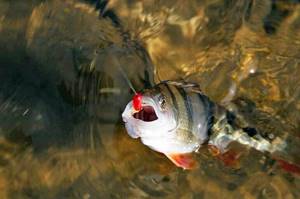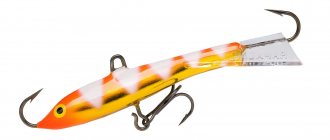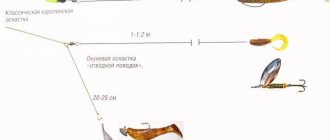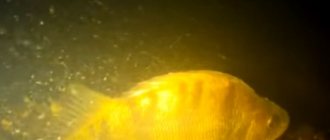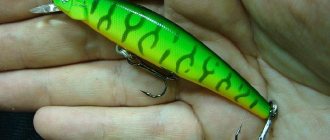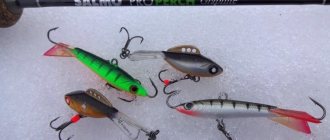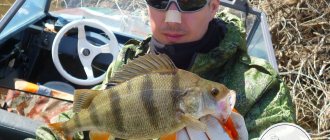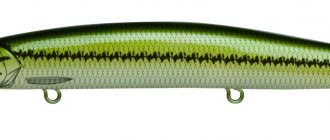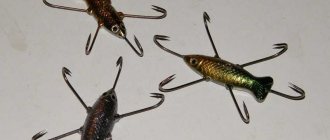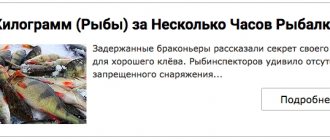Perch fishing on lakes
On deep natural lakes there is enough large perch under 2 kg, especially good catches are observed in early autumn. As a rule, the bottom of natural lakes is flat, there are practically no edges, hillocks, or boulders. There is nothing special to attach to, you have to check point by point. The only tip is that humpbacks only bite on a hard bottom, sandy with admixtures of hard gley, and there are very few bites in muddy areas. The main working depths are 4-5 m, with the existing maximum depths being 10-11 m. Perch from a kilogram and above responds well to small (5 cm) light green rubber, and it seemed like the best thing to use was an ultralight tackle with a light jig head. But it doesn't always work. If you rush with the wiring, you are unlikely to tempt a large perch to bite. Often simple dragging helps: cast, the bait sank to the bottom soil, followed by a uniform reeling, the head stretching along the bottom. From hour to hour, a smooth pull is made with the help of the rod, during which the elastic band literally comes off the bottom a few centimeters. It turns out to be a kind of “creeping”, very low step. Bites usually occur at the beginning of the break after pulling. Pike also respond well to such tactics. But if you move the bait higher, only small perch pieces will pile up. This type of fishing for perch is simple in appearance. In fact, you have to practice avoiding sudden movements. It is important to choose the appropriate weight of the load, which can exceed 14 g. After all, with a light weight, the bottom is poorly felt, you can’t get a clear pull, the bait strives to rise, and in strong winds and waves, with a light weight, control over fishing is completely lost, and throwing far is a problem. If the load is too heavy, a smooth step does not work out - to lift the bait from the bottom, you have to make a sharp movement with the rod, which can scare away the humpback whale.
There are other types of examples
There are lakes where there are plenty of perch baits, first of all these are shell-pebble mounds two to three meters high located under water, located on a deep (four to five meters) flat plateau. Such hills are characterized by a wide variety of shapes; they can be steep, gentle, small or decent in area. It would seem that standing water and relatively shallow depths would give the ultralight a chance, but again, no! Large striped fish (and neighboring pike perch) often attack the bait at the very foot of the hillock, in the place where the rise is just beginning. It happens that the fish stands higher, but usually the higher, the greater the chance of encountering only small perch and the same zander. Decent fish still stick to solid depths. For example, if the depth above the hillock is about two meters, then solid perches will be found at points no shallower than 3-4 m. Fishermen have noticed that the humpback fish gravitates towards the very bottom, this is especially noticeable in June - July. Attempts to use light jig spinning rods, with baits on 6-8 g heads, bring a lot of bites, but the perch that comes across is not large. A solid humpback fish responds well only to slowly dragging the bait along the bottom soil, which forces you to switch to heavy equipment. It looks like this (Figure 1).
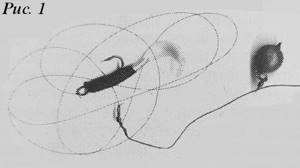
Installation of a diverter leash for catching perch
Catching perch on a retractable leash can be done using various gear. The most common types of mounting a diverter leash on a perch are shown in the figure below. And fishermen call them:
- simple equipment with one swivel;
- installation with one swivel and fishing line insert;
- sliding installation with two swivels and two fishing line inserts;
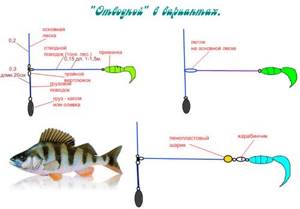
Now let's move closer to the technique of making such equipment. But before you read about each of them separately, I recommend that you watch a video that provides step-by-step instructions for making a retractable leash for catching perch.
Simple rigging with one swivel
The tackle is easy to manufacture. They are also very popular among perch anglers due to their catchability. Many fishermen praise it for their own reasons. Let's take a closer look at how to make a diverting leash for a perch with one swivel.
First take the main line and tie a clasp to it
(the function of the fastener is to secure the sinker).
Then measure 25-35 centimeters above the fastener and tie the swivel
.
That's it, all that remains is to tie the leash itself with the hook to the swivel
.
This kind of gear has one significant drawback - when fishing on a rocky bottom, the line will be damaged by the stones and there is a high probability of breaking the gear.
Installation with one swivel and line insert
An equally simple option for installing a diverter leash on a perch, but a significant drawback of the first gear can be compensated for by inserting a fishing line. This will protect the leash with accessories from rubbing against stones and damage.
The production of such equipment begins in the same way as the previous equipment. A fastener is attached to the end of the main line
.
Now you need to attach a swivel to the clasp, to which a leash with a hook is pre-attached
.
Now
(about 30 centimeters long) into the same eye of the swivel
Sliding mounting with two swivels
All the same, tie a clasp to the end of the main line
.
Take a piece of fishing line and tie a small loop at one end
.
Now tie a swivel to the other end
.
Tie a piece of fishing line with a sinker to the swivel. Now take the lead leash and fasten it to the same piece of fishing line
and tie it to the main one (via a swivel).
The movable fastening of the diverter lead significantly reduces the number of overlaps when casting. For novice fishermen, this type of equipment seems quite complicated, but it is worth spending time on its installation so that there are no problems in the future.
Heavy rig for perch
A swivel is attached to the main core (braided cord 0.15 mm), soldered into a streamlined bottom sinker (if one is not at hand, then an ordinary “Cheburashka” is used, to the eye of which the swivel is attached through a winding ring). A second swivel is tied to the end of the vein, a leash (0.2 mm in diameter), 1-1.5 m long is attached to it. A single hook (No. 7-8 according to the old numbering) with an elongated shank, it’s great if such a hook has notches (special models for fishing with a worm), reliably holding a small twister (3-5 cm) from slipping. It will be useful to glue the snag with “second glue” so that it is guaranteed not to slide off the fore-end when grabbed, if the hook is used without special notches. The weights used in the equipment are quite massive - 25-30 grams (accordingly, a spinning rod is required with a suitable test). It may seem that this is an obvious overload for standing lake water, but no, everything is logical, especially when searching for promising points. When pulling along the bottom soil, a massive sinker quickly identifies areas with a sandy and pebble bottom, where large perch like to set up their ambushes. Similar spots can also be found on a flat bottom, at a decent distance from underwater mounds, and such places are also worth checking. In addition, a heavy sinker has much better flight characteristics than light jig heads, allowing you to quickly cover wide areas.
The basic wiring option is similar to the one described above.
Cast, the sinker falls to the bottom, a uniform reeling is made, alternating with small roars produced by the rod. Skilled spinning anglers see nothing wrong with the sharp (but short) movement of the bait. At the moment of the jerk, the massive load rises slightly above the bottom and almost immediately falls back to the ground, forming a small cloud of turbidity - this drives a large humpback whale crazy. A bottom step like this is much more effective on a large striped predator, compared to a “perfectly” chosen head that jumps much higher. Only at the end of summer - beginning of autumn, when the striped robber rises for small fish high above the bottom, does the bottom wiring fail. But these outings do not last long, and you should always try to look for large perch at the very bottom.
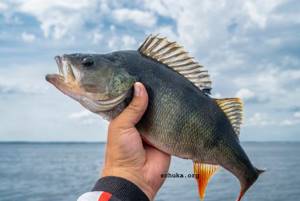
Choosing Lures for Perch Fishing in Summer
Choosing a Bait for Perch is not an easy task, sometimes it takes a lot of time to find the right bait:
If fishing is carried out far from the shore on a snagged edge or on a spit, then naturally Jig with all its different variations.
When the perch is actively feeding from the surface, then Walkers, small Cranks and Poppers are not in competition.
When it occupies medium horizons in the water, it makes sense to install a Minnow Wobbler with medium depth.
Turntables and micro-oscillators are used for fast dynamic fishing, namely when perch is highly active.
Fishing for Perch on Vertushki | Video
Catching Perch with Spinning and Rotating Spoons | Top Best Lures
The spinner is a classic of Perch Fishing. Accurate casting at a medium pace and perch on the tee. Currently, the spinner is the most popular bait for catching perch, and rightfully so.
I Got Excellent Results Using the Following Spoons:
Pontoon 21 Synchrony;
Ball Concept;
Mepps Aglia;
Myran.
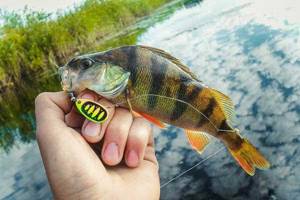
Effective perch fishing can be affected by both the shape of the petal and its size, and, accordingly, its color. Bright fluorescent colors are good in dark, rainy weather, while dull colors are most often used during daylight hours.
It is very good when the petal has bright dots and the hook has an edge. In this case, the number of bites increases significantly.
The spinner is good because it can fish not only vast shallow water, as is usually customary, but also all layers of water, from the surface to the bottom.
When the Perch is feeding from the Surface, a quick retrieve will provoke the striper to bite in any situation. Sometimes the slowest wiring is required, it is no less effective in some cases, but there is a drawback - the petal constantly sticks and stops rotating.
Wiring in the middle layer of water is also effective, most often it depends on what layer of water the minke whale is in.
Spinners | Video
Catching Perch with Spinning and Oscillating Spoons | Game and Posting
As for Oscillating Spoons, things are not as good as with Spinners.
The thing is that the spinner has a completely different game and wiring technique, and the perch likes this less.
You can carry out the Kolebalka on the same horizons as the Rotator, but these are two different baits with their own directions. It is best to move the oscillating spoon along the bottom, making explosions and light pulls. Perch, seeing the swarming at the bottom, reacts to this with lightning speed.
You can also give long pauses at this moment, the spoon sails in the water column, attracting the perch with the shine of its surface.
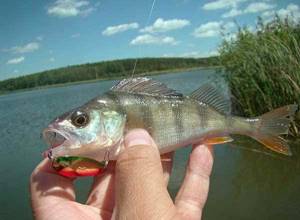
Catching Perch with Spinning should be carried out using the smallest sizes of spinners, namely 3, 4, 5 centimeter baits. This way I catch different sized perch.
If you want to drive small perch away from your bait, then it makes sense to increase the size of the spoon. The color of the spinner also affects the bite of the perch.
Over the years of practice, I realized that stripers love not just shiny baits, but poisonous ones. Don't be afraid of red, pink, yellow and green.
When fishing for perch, I often use Trout Spoons from famous manufacturers, such as Megabas , Meps , Pontoon 21 , Acme .
Trout Lures The perch attacks with such passion that sometimes it seems that it is a pike, but in fact the perch always attacks trout spoons much more fiercely than spinners - this is the essence of such fishing.
I caught my Largest Perch using the Kolebalka, although I rarely use them. The size of the trophy was over one and a half kilograms. From that time on, I began to believe in oscillators.
An oscillating spoon is completely useless to use in shallow water. Due to its mass and geometry, the spoon will quickly fall to the bottom and cling to the grass or soil. It is possible to find something in between, but to do this you need to experiment through trial and error.
3 ways to improve your fish bite!
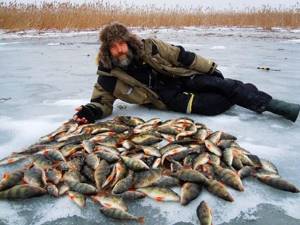
Over 15 years of active fishing, I have found many ways to improve the bite, and here are the most effective:
1. Bite activator . This pheromone additive attracts fish most strongly in cold and warm water. The Fish Hungry bite activator has proven itself to be excellent - Read more…
2. Tackle with increased sensitivity . You should first familiarize yourself with the features of using a particular type.
3. Pheromone baits . They attract the attention of fish, stimulate hunger and cause a schooling reflex, which allows you to collect a lot of fish in one place.
You can get the rest of the secrets of successful fishing for free by reading my other materials on the site.
3 ways to improve your fish bite!
Over 15 years of active fishing, I have found many ways to improve the bite, and here are the most effective:
1. Bite activator . This pheromone additive attracts fish most strongly in cold and warm water. The Fish Hungry bite activator has proven itself to be excellent - Read more…
2. Tackle with increased sensitivity . You should first familiarize yourself with the features of using a particular type.
3. Pheromone baits . They attract the attention of fish, stimulate hunger and cause a schooling reflex, which allows you to collect a lot of fish in one place.
You can get the rest of the secrets of successful fishing for free by reading my other materials on the site.
The best element of any Oscillating Spinner is areas with great depth and, of course, Snag. The wiring technique here is completely different. We need to perform a long sailing retrieve, as a result of which the spoon oscillates smoothly.
It is during the fall of the spinner that the majority of all bites occur. This is what catching perch with an oscillating spoon is typical for.
Oscillating Spoons | Video
Cicadas and Spinnerbaits | 100% Result
All Predatory Fish are impatiently awaiting the release of such a bait. Of course, you understand that we are talking about the Cicada; when it gets into the water, a stir begins, the fish strives to jump out.
When fishing with Cicada, you can be 100% sure of the result. You can carry out the cicada in the same way as the Kolebalka.
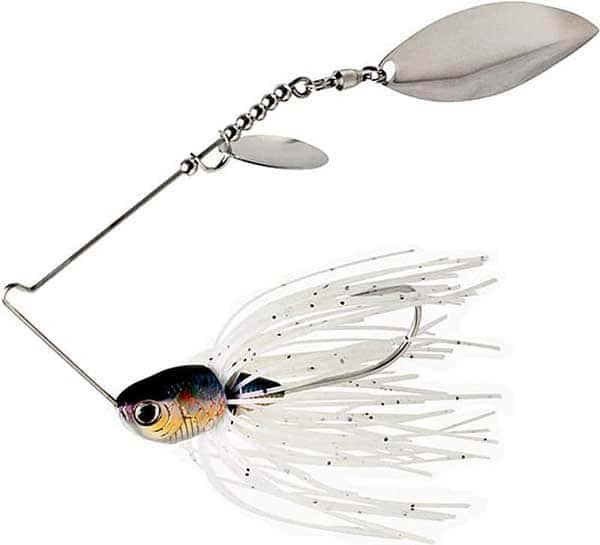
The high-frequency play of this bait will not leave the perch on the sidelines. Jig Wiring and simply Uniform Wiring are also possible.
Small Spinner-Bates make the perch lose patience immediately when they hit the water, because the Spinner-Bate is both a Silicone and a Rotating bait rolled into one.
This type of bait creates a lot of vibration in the water, which is also accompanied by noise. And the perch is simply obliged to grab it and not swim past.
Silicone Lures | Wiring Size and Technique
Now it’s time to move on to Silicone Lures. I’ll say right away that there is no limit to your fantasies. Twisters, Vibrating Tails, Grabbers and Silicone Worms are the spectrum of silicone that I usually choose when fishing for Perch.
Most soft plastic fishing is done in deep water where the largest bass are found. It would be stupid for me to advise anything, but here are a few companies that, in my opinion, hold the palm in perch fishing:
Relax;
Action Plastic;
Mister Twister;
Manns.
Vibrating tails and Twisters from these companies always occupy a high place in my box. The most important thing is to choose the right size of bait; if the perch is active, then it is better to use a bait that has an active, realistic game.
When the Striped Activity is Low or Tends to Zero, I Apply:
Passive Silicone Worms.
Pay great attention to the Technique of Posting and Presentation of the Bait. Don't get hung up on just one Jig, because there are things that are much more effective, for example, Carolina or Texas, Drop Shot and Pull Lead.
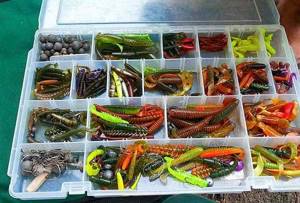
Soft Plastic Lures | Video
Perch in autumn on lakes
In the fall, hunting for large perch in deep lakes is a real joy! You hook a one-and-a-half-kilogram pig at a depth of 12 meters and sit with round eyes - you can’t tear the fish off the bottom! Then he went - the line was already buzzing, you let go several times and let him down again - beauty! Almost all year round, humpback whales stay on hills - hills among the depths. The falls from these slides can reach a decent figure from 6 to 18 m! Small perch are at the top of the hump next to the grassy bottom. You check 2-3 m below, and there are striped ones at 300-400 g, and somewhere a little lower there are real giants. The distances between these points are small, they check for the presence of perches quite quickly, but in order not to miss, the place is fished very carefully. This is only possible with a fairly heavy jig. At the same time, there is always an intrigue - large pike are caught around perch slides, accordingly, the tackle for perch should have a margin of safety, but a metal leash is rarely installed - the main target is for large perch, which in clear water does not like metal in equipment.
This deep jig is practiced by few spinning anglers; on lakes, horseback fishing is more popular, when schools of perch rise and fish no deeper than 2 m from the surface of the water. But the fish are no more than 300 g, only occasionally more respectable stripers are caught. Still, the real lake humpback whale is, as a rule, deep-dwelling.
Big bass on a topwater popper!
And in reservoirs there is a direct relationship - the larger the perch, the lower the chance of catching it in the upper layers. Only small “sailors” actively move throughout the entire thickness of the water, often they cannot be caught at the bottom, and the humpback whale literally presses its belly into the very bottom. But if the reservoir has a very high density of perch and, accordingly, there is tough competition there, then fishing often happens when a perch weighing 1-1.5 kg, even at depths of 4-5 m, is taken on... a surface popper! Somehow, at the beginning of September, my friends and I ended up at the same reservoir. There wasn't much bite. And then a friend got it into his head to launch a popper that seemed so unsuitable for fishing conditions for perch. It’s a miracle, but on almost every retrieve, humpback whales landed, often missed, but again and again pounced on the bait, even when they were clearly hooked! And the hard leash made of guitar string did not scare them away. And the perch didn’t care at all what color the bait was – natural colors and bright ones worked equally well. The same goes for wiring. There was no one in particular that brought in the most fish. The best bite was with a small wave (not a ripple, but a wave), cast in the wind, pulled against the wave. When there was calm, the bite did not subside, but worsened. Only one question remained unclear: did the perches shoot for the popper from the bottom (as pike often do) or hung in the middle layers of water among the vines of various algae, where most of the bites were? In any case, it is surprising that the popper worked, because the best conditions for its use are warm summer water in shallow waters, where only small and medium-sized perch are caught with this bait. But what’s interesting is that as the water got colder, the popper worked worse and worse.
Posting a spinner for perch in the winter when there is no bite. The main types of wiring for winter spinners.

It would seem - what could be simpler! Especially in winter lures... I lowered the lure under the ice and began to lure the fish with even strokes, forcing it to bite... If only everything were so simple.
The amount of fish caught directly depends on the ability to choose the correct wiring in a given reservoir at a specific time. In my luggage there are several dozen different ways of guiding vertical spinners. It will not be possible to describe all of them in one article, and there is no point. But it’s worth talking about the basic principles of the game and what you should pay attention to.
This is the first and most important parameter for any wiring. For some reason, most spinners believe that no matter how you throw the bait, a predator will still covet it. Therefore, anglers hold their fishing rods suspended, can easily change the hovering horizon of the bait during a pause, and at the same time make a lot of unnecessary movements that violate the moment of “absolute” rest of the bait. As a result, where it was possible to catch several dozen perches, one or two are caught, and where there is a single perch, you may not wait for a bite at all.
Any wiring must be firmly fixed in the final phase. For example, let's say you're doing a lifting game cycle. At the same time, check the horizon up to a meter above the bottom. After each swing, raise the bait by 2-3 cm. If you start working from the bottom, first fix the fishing rod on an outstretched leg, and during the next swing, lift it, bending your leg at the knee by these same 2-3 cm. When the height begins to not be enough, pull it out forward your left hand and shift the fishing rod onto it. Fix the rest of the lift with your hand. This allows you to constantly control the bait and feel the rhythm (we'll talk about it a little later). If you are doing a lowering maneuver, then repeat the movements exactly the opposite.

Fixing the lure at the moment of its transition from a state of movement to a state of rest is one of the most important elements in winter lures. It is during this period that a low-active predator can decide to strike.
With a fixed retrieve, you accurately determine the horizon at which the predator “touched” your bait, which means that by stopping the rise, you can work for some time in one plane above the bottom, which is important when catching passive fish.
The second main component. By fixing the spinner and making the correct (in your opinion) wiring, you can achieve some success. But if you do not pay due attention to the rhythm, then you will definitely “lose” some of the fish.
The ability to keep a rhythm is the key to your success in fishing. Because, strange as it may sound, it is its observance and timely violation that makes it possible to “collect in a bag” all the fish standing under the hole.
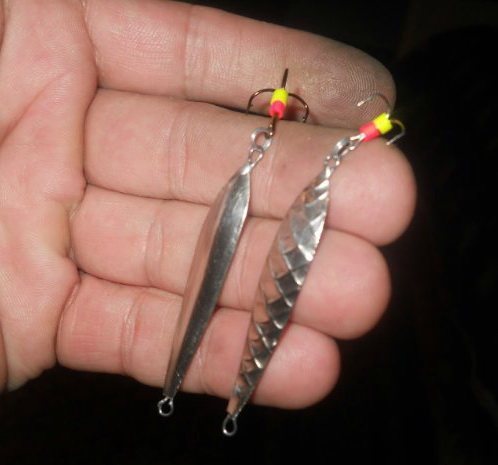
The predator is extremely irritable to the same type of rhythmic movements of the bait. If you do not disturb its play with unnecessary tremors and illogical changes in the horizon, the most active individuals will quickly demonstrate themselves with bites and will be caught. But passive fish can be caught precisely with the help of micro changes in the rhythm of the retrieve. Let's say you are making a retrieve in one horizon, moving every four seconds, all active fish have already been caught. The next time you lower the spoon to the desired horizon and after 3-4 fixed swings, try to pause for 6-7 seconds.
The same thing can be done simply during the next retrieve, when the fish has not yet shown itself in any way.
At first it seems very difficult to keep the same rhythm. It all depends on the training. When I started to master this method, I simply counted to myself. Subsequently, the same type of rhythmic movements became as natural as breathing, and I no longer think about it.
This is worth talking about separately. Along with fixation and rhythm, the pause plays an equally important role in correct wiring. It is selected specifically on the reservoir at the time of fishing and directly depends on the activity of the predator. When going out on the ice, you should start with a classic pause. If we talk about perch, this is 3-4 seconds between swings. Pike or pike perch “love” longer pauses - from 6 to 15 seconds.
It is worth changing pauses at the beginning of fishing from the first holes. Make a classic retrieve, and during the next cycle try to increase the rest time of the spinner by 1-2 seconds. At some point, stop wiring altogether for ten seconds. Within half an hour, having received the first fish bites, you will already understand what kind of pause the fish currently needs, and you will start another search only if the bite stops for an unmotivated reason.

Even experienced lure fishermen with many years of experience behind them often forget to check the water thickness while fishing. This is an unforgivable mistake. I can say with confidence that almost every fishing trip I catch part of the fish in the horizon from half-water to the entrance to the hole. At the same time, fishing can quite easily take place at depths of 4-5 m or more. So that less time is wasted on this action, if the bite fades at fixed depths, when moving to the next hole, I begin to lower the fish directly from the hole. This method not only saves time, but also finds a new working horizon faster.
I fix the fishing rod on my outstretched left hand and begin to lower the spoon with even strokes. Having lowered my hand to the hole, with a quick movement, trying not to change the horizon, I unwind a meter of fishing line and at the same time again raise my left hand up to fix the bait. I continue to do this until the spoon touches the bottom or a bite occurs.
Another important point is changing the horizon when fishing after a sluggish bite or in a promising area of the water column. For example, in the same way and rhythmically, after the next swing and the resting phase of the spoon, lower or raise the bait a few millimeters. Sometimes only such wiring forces a passive predator to grab.
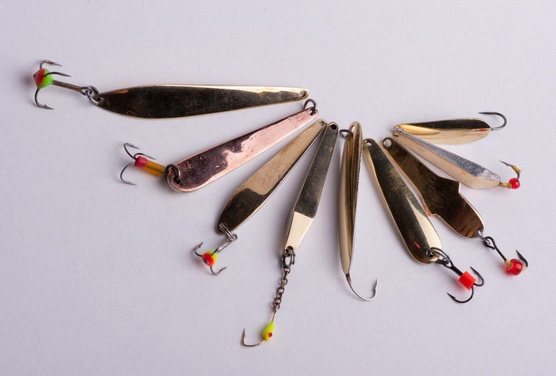
I believe that the ability to play a lure on the bottom is one of the pinnacles of a lure angler's skill. Firstly, it is when working with bait on the ground that the presence of a perch under the hole is revealed most quickly, which means you do not waste time on unnecessary cycles. Secondly, and such cases happen very often, perch can only be caught from the bottom. He simply does not react to playing in the water column. First of all, in my opinion, it depends on sudden changes in pressure. Be that as it may, the fact remains a fact.
Just a couple of years ago, I believed that for bottom play the only possible and correct spinners were those with a soldered hook. Now, with the accumulation of experience, I can safely say that baits with a suspended tee can be safely lowered to the bottom and worked there correctly. The only inconvenience is that the tee collects bottom debris, and snags occur more often.
The game options are different. From launching a gliding bait with a wide swing several tens of centimeters away from the drilled hole and slow rhythmic dragging, to simply moving the spoon on the bottom under the hole. Just don’t forget about uniformity and pauses.
Having worked out the above elements in practice, you can easily lay them as the basis for any wiring you come up with. But without these basics, no wiring will be complete and effective. At the same time, it is impossible not to mention that all this can be fully accomplished only if you have balanced tackle with a sensitive nod, even if your reservoir contains only large perch (as fishermen often claim in conversations) and its bites are sharp and decisive . This happens when the predator becomes active, and it is not always active. You have to catch fish whenever you go to a body of water.
There are many ways to play spinners. This depends on the speed of the retrieve, the depth, the bait (its weight, flight qualities), and the activity of the fish. But there are several basic ways to play that you need to know and bring to automaticity:
The spoon is sharply placed on the bottom, after a second pause its body is raised so that the hook remains lying on the ground. A second pause and the operation is repeated. After 5-7 cycles the game can be replaced;
The spinner, having accurately determined the depth and fixed the hand, hits the bottom. At the same time, due to the elasticity of the nod, it comes off the ground and hovers above it a few millimeters (5-7 cycles);
The spoon is lifted up with gentle strokes (several centimeters each). After each swing there is a short (less than a second) pause. In this way, the entire thickness of the water is checked, right down to the ice;
The spoon is raised and lowered to the starting point with short strokes (a few centimeters each). In this case, the pause can be extended for several seconds. Play the same way;
Before starting any of the postings, you can try to make several wide strokes with the fishing rod without stopping and freezing the bait. Sometimes it helps to attract fish from afar.
Read other articles, reviews and testimonials:
- Catching perch in winter. Basic fishing methods. Tactics for catching perch in winter
- What weight should I choose for installation on the girders? Sliding or fixed weight on the rack?
- Where to look for crucian carp in April? Choosing a place to catch crucian carp in April
- Review of Rapala winter fishing rods. Reviews from fishermen about Rapala winter fishing rods
- Which ice screw to choose? Characteristics and important parameters of ice screws for winter fishing
Perch rig with spoon and ripper
Instead of a popper, experienced spinning anglers successfully use a kind of perch rig: a 0.25 mm fishing line, a steel leash 15 cm long, a 14 g oscillator, and a 3.5 cm long ripper is attached to the top of the leash on a double. This rig (Fig. 2) is compact, a ripper can be easily can be removed without being overwhelmed. There are various types of wiring - uniform, wavy, step, jerky. On one fishing trip, the perch takes better on a small ripper hook, on another, it prefers to attack the spoon itself. It happens that the humpback whale’s priorities change even during the day. Or like this: a bite, a hook, sitting dearly on the upper ripper, I was just about to take the fish with my hand, when another perch jumped out from under the boat and grabbed the spoon!
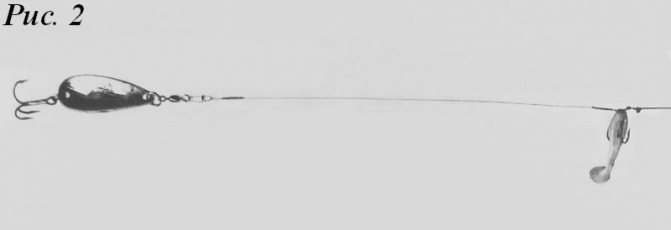
In general, oscillating spoons give a lot of bites from large perches, most of them are a pleasant by-catch when pike fishing. Although some spinning anglers also use spoons for targeted perch hunting. The spinner is especially good for “sorting” large perch among dense schools of small and medium-sized fish - even spinners No. 3-4 are actively attacked by small stripers, literally pulling themselves onto a large tee, and the spinner rarely and accurately brings well-fed humpbacks. True, this bait is considered quite difficult to master - if for a spinner the simplest uniform slow reeling is good, then with a spinner you have to experiment thoroughly, choosing the right reeling - faster or slower, with pauses or evenly, with short jerks, etc.
The humpback fish bites on all types of spoons, although more often it takes on narrow models classified as “river”. Throughout August and September, experienced spinning anglers prefer to catch perch using the green cicada, also a kind of spinner. A cicada for perch requires a large, heavy one, capable of penetrating the depths of 7-10 m with bottom wiring, where gorgeous minke whales weighing over a kilogram most often fly in.
Tackle for catching perch in winter on a balance beam
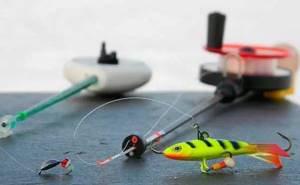
The stores have a huge selection of all different winter fishing rods. From expensive sports ones to cheap “Chinese” ones. However, for fishing with a balance beam, you can take a regular one with a handle. In some cases, it is quite reasonable to use a balalaika. The selection criteria are simple:
- Comfortable to hold in hand.
- Ability to withstand frost and periodic impacts on ice.
- It is desirable to have a reel or built-in spool. When fishing with a “filly”, which is also possible, the role of the reel drum is played by the reel.
- A whip with a tulip at the end, or with a nod.
The length of the rod for fishing with a balancer is preferably 30 - 35 centimeters. It is most convenient to work with a rod of this length from the ice. When we talk about wiring, I’ll explain why.
Based on the flexibility of the whip, I formed my own opinion. I will voice it.
I question the advice that the whip should be flexible to dampen the jerks of large fish. The fact is that fishing with a balance beam is not just throwing bait in the water column. It is necessary to control the play of the balancer and eliminate unnecessary, parasitic nodding of the rod tip.
Therefore, it is better to have a short, fast-acting whip equipped with a nod on the fishing rod, rather than a noodle that falls under the dropping of the balancer. Even if the deflections made are insignificant.
What kind of restraints on the jerks of a large perch, for example, are we talking about if fishing is not done by using a reel, but by reeling out the fishing line with your hands?
I agree that it’s easy to tear a perch’s lips when you strike with a lightning-fast sharp hook with a stake-shaped rod. However, there is no need to cut widely and powerfully.
The opinion is purely personal. I am ready to listen to a refutation. For an angler just starting to catch perch on a balance beam, it will be useful to listen to the athlete’s recommendations.
fishing line
Catching perch with a balance beam involves using baits of different weights. Plus, at the fishing point there are always quite snag areas. Therefore, I recommend using fishing line from 0.18 to 0.25 mm. Or have a couple of fishing rods in your arsenal, equipped with different diameters. For example, on one it is 0.18 - 0.2, and on the other it is 0.22 - 0.25.
This will allow you to fish from ice at shallow depths with small balancers and when going to depths of 8 - 10 meters with large weights without any inconvenience.
The line for catching perch on a balance beam in winter is a regular monofilament line. I tried to equip the balance fishing rod with a fluor, but somehow it didn’t work out.
When describing catching bream with a devil, I already said that I don’t particularly believe in the production of special winter fishing lines . In my opinion this is a publicity stunt.
Balance
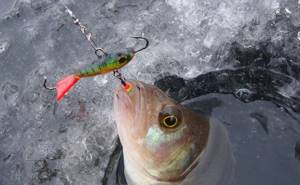
The balancer bait is a “parody” of a small fish. They are made mainly from lead. Although, on the Internet there were models of balancers made of dense and heavy plastic (I believe that we are talking about mebaru (mod.)).
The main characteristics of the balancer are size, weight and color. It is these features that fishermen mainly pay attention to.
Balancer shape
According to the equipment of the “tail”, balancers are divided into:
- With stabilizer. The most popular form of bait.
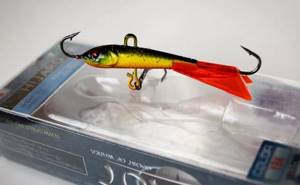
- With tail unit.
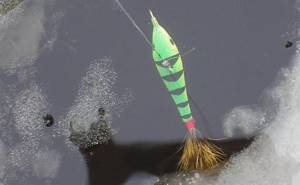
The game of balancers with soft tails involves light, smooth movements, during which the tail fluffs up. There is no need to talk about figure-of-eight movements here.
On one of the sites about winter fishing in Finland, balancers of this shape are defined as jigs.
Perch size of balancer
Catching perch with a balance beam in winter or summer, like any other fishing, always involves using bait sizes in accordance with the size of the expected fish and its activity. Therefore, the size of the balancer is an important selection criterion.
The universal length of a balancer for a perch is considered to be from 3 to 4 cm.
However, I can assure you that, having scattered a flock of “pissy” minke whales, a balancer in the size of 5–7 centimeters works no worse.
There is information that a stabilizer painted red visually under water increases the size of the bait by the length of this tail.
As for the weight of the balancer, there is a direct dependence on the fishing depth. Below is a table downloaded from one of the forums. I would like to immediately warn that the “depth-weight” indicators should still be considered with an error.
| Fishing depth (m) | Weight (g) |
| up to 2 | 3-4 |
| 2-4 | 5-6 |
| 4-6 | 6-11 |
| 6-7 | 12-18 |
| 7-9 | 20-25 |
| 10+ | 30+ |
Balancer color according to perch
When collecting your treasured box of balancers for catching perch, you still have to spend time. What color of bait will be respected by the striped fish of your pond - only experiments will show.
At the same time, we can recommend three working colors that should be used as a starting point:
- Under the Christmas tree. Dark back, silvery or slightly greenish side.
- Acid tank for perch.
- Nondescript, gray like a perch.
These three colors are generally popular with bass. Also, the presence of blue or turquoise does not repel the tabby.
When catching perch with a wobbler, I noticed that the presence of shades of blue gives good results when fishing at depths of 3 meters or more.
Large minnow wobblers
On shallow lakes, minnow wobblers are successfully used for perch, and rather large ones (12-13 cm). Usually these are suspenders. A leash made of thin, durable material is practically mandatory - the bait is regularly attacked by pike, often of very respectable size. In general, according to the classics, it is believed that when fishing for pike, the main advantage of a suspender is the ability to hang in the water column during pauses in the jerking retrieve. But fast, even retrieving works better for perch. It turns out to be very effective in the summer heat; it perfectly lures fish out of flooded bushes and grass, where perches like to hide in hot weather.
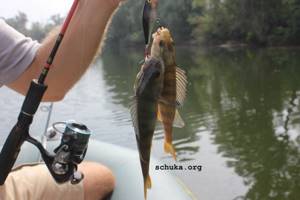
Fishing for perch in rivers
On rivers, large baits also produce excellent humpbacks. For example, a special “perch style” of searching for humpback whales from river cliffs is practiced. Take a powerful spinning rod with strong braiding around 0.2 mm. The scout bait is hooked - a deep-sea trolling wobbler with a diving depth of 5-6 m (classic floating Rapalovsky “shadrap” 9 cm, other similar models are also suitable). Perch fishing is done from steep banks, without going down to the water's edge, even if the height of the cliff is 3-4 m. They cast across the stream (or a little higher up the stream), make several quick turns, the diver instantly reaches the bottom, followed by a uniform slow retrieve. The wobbler can also be driven jerkily - pull the rod about a meter, then the tip of the spinning rod is moved forward, followed by a quick removal of the slack in the fishing line, another retrieve, and so on, until the bait approaches the shore. Despite the fact that the depths near the shore can be no more than 2-3 m, a deep-sea wobbler works great, regularly scratching along the bottom (perch really likes this), despite the line going up steeply. And there are fewer hooks than with jig fishing - the wide blade does a good job of repelling the bait from small snags.
Perch on the spring river
In the spring, in May, when the perch feeding begins, rubber comes to the fore, especially on small and medium-sized rivers. Large perches, weighing 500-700 g, often settle in coastal barrels - holes covered by bushes and trees hanging over the water itself. The most proven technique to help tempt a humpback whale to bite in such places looks like this. A large twister (10 centimeters) on a 12 gram jig head is thrown under overhanging branches, right into the hole, the perch bites when the bait is immersed or literally in the first centimeters of the retrieve. If you don’t take the bait right away, you won’t take it anymore – you can quickly reel it in and try to cast it a few more times. If there are no bites, it is advisable to move to another similar place.
Wire rocker for perch
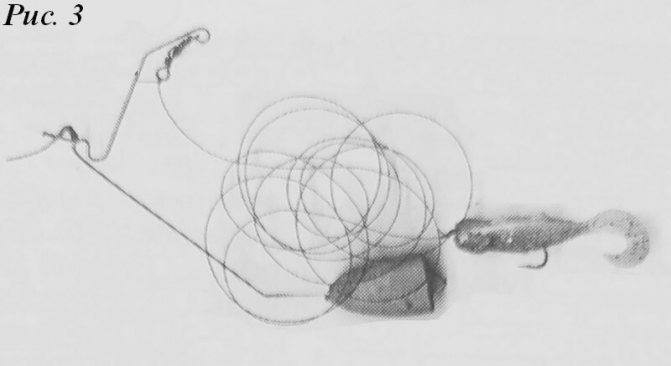
In river areas with an uneven bottom, a wire rocker is popular (Fig. 3), which carries the load and bait on a separate leash, preventing them from getting tangled, working as a sort of outlet. The bait (usually a small twister or ripper) is put on a regular hook with a long shank. The leash is relatively long, a meter or more, this improves the play of a small bait, and the fish will not be afraid of the load. The latter usually goes above the very bottom or “crawls” along it. The greater the depth, the strength of the current, the steeper the edges, the more massive the load needs to be placed - the weight limit is imposed only by the test of the rod itself. Often, skilled fishermen, on rivers with fast currents, drag perches one after another onto a miniature ultralight twister with a load of up to a hundred grams! By the way, spaced rigs are also popular in quarries with broken bottoms, where even a jig fails on almost vertical edges, but the rocker handles it perfectly. Experienced fishermen use spaced equipment in quarries without a wire outlet. At the end of the fishing line, a load of about 20 grams is attached through a swivel; above 25-30 cm, a meter-long leash with a hook and twister is tied (Fig. 4).

This kind of equipment is used not only for fishing with classic casts, but also for leisurely rowing, looking for fish in promising places. In any case, the weight stretches along the bottom, “licking” all the edges, even the steepest ones, and the twister always goes where it needs to - just above the bottom. The equipment allows you to quickly calculate the bottom topography, find spits, pinpoint mounds, holes, rocky bottom, snags, etc. A twister, not burdened by a jig head, is easily swallowed by perches, hooking as such is by and large not needed, the striped ones are caught on their own.
With a rocker they hunt for large perch in rivers not only in holes, but also along riffles, mainly along the return stream or at the border of the main and return streams. Good specimens can also be found in fast currents before a riffle. In all these places, in addition to the complex current, significant differences in depth are also common, but the perches stay near the bottom, and it is not easy to properly fish such places. Fans of rolling wading ultralight demonstrate the highest class with small wobblers and spinners, enjoying the difficulties of fishing. Those who prefer a rocker assure that with it it is quite easy to fish even the most tricky, rolling areas with a simple uniform retrieve. In addition, the casting range is an order of magnitude higher than with ultralight baits, which allows you to quickly “break through” a riffle without even going into the water. This advantage is especially significant in the spring with a spring ban. But precisely this month, in still high water, there are a lot of decent-sized perches hanging around in the riffles. After the level drops, the shallow riffles are occupied by small perch and chub, but as soon as there are good rains, the water level rises again, and the perch are here again.
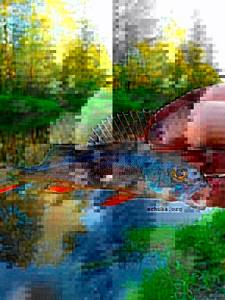
Perch riffles are often large in area, and fish do not hold evenly on them. And experienced perch fishermen carefully plan their daily routine. Usually in the morning there is a search for striped fish in the coastal zone of the river riffle. Then during the day there is a wide search throughout the entire water area. In the early evening, conscious fishing is already underway at the points that worked during the day and especially in the morning - the morning exits of perches to the shores are very often duplicated in the evening and bestow excellent catches literally at the end of the evening dawn. Traditionally, the perch zhor is cut off with the advent of darkness - the striped fish is almost always and everywhere a typical “daytime” predator; at night it almost does not feed and is very rarely caught by spinning rods. Big sleepyhead this perch!
In general, in purposefully catching large humpback salmon there are more questions than answers, but solving the “perch mysteries” brings real pleasure to the spinning angler. Of course, if you measure catches only in kilograms, and try to impress your family and friends with large trophies, then perch is not the best choice. But why, when we remember our spinning trips, do many of us see not huge pike perch and pike perch, but the image of a handsome humpback fish clad in dark green armor!?
Spinning rigs for perch fishing
When fishing for perch over large areas with a relatively clean bottom, so-called spaced rigs are used - “Carolina” and “Moscow”. In the Carolina, the bait is at the end of the line and the sliding weight is above the leash. The bait is usually a twister, preferably floating. In the “Moscow rig” the load is at the end, the leash with the bait is located 20-30 centimeters higher. Another name for it is a retractable leash. The Texas rig is very good for snags. The bait, usually on an offset hook, is below, and above it, on a leash, is a bullet-shaped weight.
For spaced installations, it is advisable to use “edible” silicone. The sensitivity of the gear and the type of installation of the equipment do not always give us the opportunity to see the fish bite or feel it “in the hand.” “Edible” will give us the necessary head start in time, since the predator does not immediately spit out the bait, holds it in its mouth longer, and may even swallow it.
Unfortunately, my experience in fishing with these baits is very limited, but this summer I did catch one fat fish using an “edible” one. It was in the Vorskla delta near the village of Kishenki. Sunny day, absolute calm, complete lack of bite. Despite the complete absence of bites from everyone, one good fish did take it. It was, unfortunately, not a pike perch, not a large perch, but a pike. She swallowed a bait called Swing Impact from Keitech, 3 inches long.
This bait is a round vibrating tail with an elongated ribbed body and a rather large heel at the end. Her game is high-frequency (what the doctor ordered for perch). A two-inch size will be just right.
For targeted fishing of attractive places, it is very appropriate to use the Dropshot rig. In this case, the weight is located at the end of the line, and the bait is directly on the line above the sinker. Hooks are used both regular single hooks and offset hooks.
Lures are mostly “passive” silicone, the action is given to it by the movement of the spinning rod. The “edible” properties of silicone will be just right here. Fishing itself is slow, but irreplaceable when fishing for deep snags and rubble of stones, where the largest perches are found.
When playing with bait, the weight remains in place, the line is given slack (the bait smoothly sinks to the bottom), then the slack is removed with micro-jerks. It turns out that the silicone fish (necessarily sinking) seems to imitate some kind of sluggish creature, trying with its last strength to break away from the bottom. It is believed that the colder the water, the smoother and more passive the wiring should be, but this is not an axiom.
You need to experiment with the pace of wiring. Perch, as a rule, is “turned on” by sharp jerks of the bait. When wiring baits, it is advisable not to use only the “Russian classics” - wiring with just a reel, but to diversify the game of silicone by manipulating a spinning rod. For example: “double blast” - a sharp toss of the bait with the tip and again tossing and choosing the slack of the cord.
